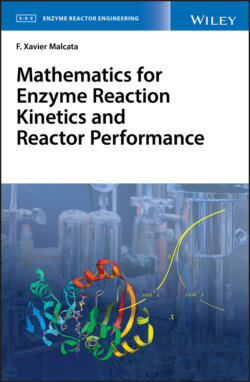Читать книгу Mathematics for Enzyme Reaction Kinetics and Reactor Performance - F. Xavier Malcata - Страница 25
2.2.3 Factorization
ОглавлениеAn alternative statement of the result conveyed by Eq. (2.154) is
(2.158)
at the expense of Eq. (2.141) – or, in view of Eqs. (2.135) and (2.146),
Eq. (2.159) indicates that x − r will be a factor of polynomial Pn whenever r is itself a root of Pn . This very same conclusion may be achieved after recalling that a function, f {x}, may in general be represented by an infinite series on x, i.e.
(2.160)
according to Taylor’s theorem (to be derived in due course) – where ξ denotes any point of the interval of definition of f {x}; in the particular case of an nth‐degree polynomial, the said expansion becomes finite and entails only n + 1 terms, according to
with the aid of Eq. (2.135), for the simple reason that dn+1 Pn /dxn+1 = dn+2 Pn /dxn+2 = ⋯ = 0. Under such circumstances, Taylor’s coefficients look like
(2.162)
in agreement with Eq. (2.161) – which may be condensed to
where a1, a2, …, an−1 denote intermediate coefficients of Taylor’s expansion; one eventually obtains
(2.164)
after merging Eqs. (2.161) and (2.163), or else
upon straightforward algebraic simplification. If ξ = r1 is a root of Pn {x}, then
(2.166)
by definition; hence, Eq. (2.165) degenerates to
(2.167)
– so x − r1 may be factored out to produce
therefore, r1 being a root of Pn implies indeed that x − r1 is a factor of Pn – in full agreement with Eq. (2.159).
Inspection of Eq. (2.168) indicates that an (n − 1)th degree polynomial has been produced, viz.
which may be reformulated to
(2.170)
– obtained after applying Newton’s binomial formula (to be derived shortly) in expansion of all powers of x − r1, and then lumping terms associated with the same power of x so as to produce coefficients bj; one may again proceed to Taylor’s expansion of Pn−1{x} as
in parallel to Eq. (2.161), since nth‐ and higher‐order derivatives of Pn−1{x} are nil. The resulting coefficients in Eq. (2.171) read
(2.172)
or, equivalently,
here b1, b2, …, bn−2 denote intermediate coefficients of Taylor’s expansion. Equation (2.173) may then be taken advantage of to rewrite Eq. (2.171) as
(2.174)
where cancelation of (n − 1)! between numerator and denominator of the last term unfolds
If one sets ξ equal to a root r2 of Pn−1{x}, abiding to
(2.176)
then Eq. (2.175) simplifies to
since x − r2 appears in all terms of Eq. (2.177), it may be factored out to yield
– so insertion of Eq. (2.178) transforms Eqs. (2.168) and (2.169) to
as long as
(2.180)
The above process may be iterated as many times as the number of roots – knowing that an nth‐degree polynomial holds n roots, i.e. r1, r2, …, rn (even though some of them may coincide); the final polynomial will accordingly look like
(2.181)
– in line with Eqs. (2.165) and (2.175), and consequently
will appear as general factorized form of any given polynomial, as suggested by Eqs. (2.168) and (2.179).
One important consequence of the extended product form of Eq. (2.182) is that the coefficients of each power in the original polynomial Pn {x} bear a direct relationship to its roots, according to
generated with the aid of Eq. (2.135). For instance, the independent term of Pn {x} must result from the product of only (−r1) × (−r2) × … × (−rn) of factors x − r1, x − r2, …, x − rn, respectively, in Eq. (2.182), so one may state
(2.184)
similarly, one finds that the highest order term in Eq. (2.135) will necessarily result from the product of only x × x × ⋯ × x of factors x − r1, x − r2, …, x − rn, respectively, in Eq. (2.182) – thus leading to the trivial result
(2.185)
By the same token, the terms in xn−1 of Eq. (2.135) are accounted for by the product of x in x − x1, x − x2, …, x − xi, x − xi+1, …, x − xn, respectively, of Eq. (2.182) by –ri in x − ri, thus generating ; this is then to be extended, via addition, to i = 1, 2, …, n, thus eventually giving rise to
(2.186)
as apparent in Eq. (2.183). The coefficients of all remaining terms can be generated in a similar fashion; for power xn−j in general, the x’s of n − j factors of the x − ri form are to be picked up, and multiplied by the remaining j roots of the ri form – and the results added up, thus unfolding a composite set of j summations that account for all such combinations. Special care is to be exercised to increment the lower limit of each summation by one unit relative to the lower limit of the previous summation, and decrement the upper limit of each summation by one unit relative to the upper limit of the next summation; in this way, each possible combination is counted just once (as it should).
